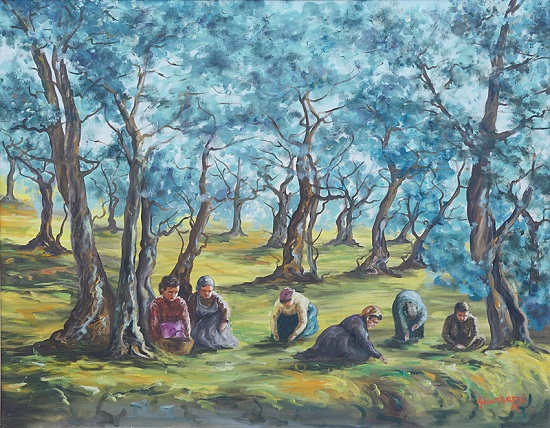Olive Tree and Craftsmanship
The roots – a bit of history
Several studies identify that the first plants of Olive Tree were probably found in West Asia, and that their characteristics are deeply linked to the history of humanity. Fertility and rebirth; a symbol of peace and value, an element of strength and purification; resistant to the ravages of time and war, the olive tree has always been a symbol of the transcendent spirituality and sacredness.
Ascertained that the cultivation of the plant originated at least 6000 years ago, its likely original habitat was Syria, where the peoples of Semitic culture were the first to think of transforming a wild plant into a domestic species. From there, its relocation in Greece was easy and from that moment it became essential to the ancient peoples of the Mediterranean.

In ancient Greece the victorious Athenians were offered an olive wreath and a cruet of oil, while the ancient Romans entwined olive branches to make crowns, with which they reward the bravest citizens. Moreover, the athletes, particularly those who were engaged in battles, used to splatter the muscles of pure oil in order to both warm them and to be able to break free more easily from their adversaries’ grip.
Characterictics
The olive tree belongs to the family of Oleaceae. The plant begins producing its first fruits at about the 3rd-4th year of vegetation and begins full productivity around the 9th-10th year; the tree reaches maturity only after 50 years. It might seem a long period of time but in fact, it is not – as we are talking about a very long-lasting plant. If the climacteric conditions are favorable, in fact, an olive tree can live for thousands of years. Its roots are very shallow and expanded; usually they never go beyond 60-100 cm of depth.
The stem is cylindrical and twirled and very often the olive trees are real works of art, in front of which it is impossible not to stop to admire the masterpieces that nature has created. The bark is gray or dark gray and the wood is very hard and heavy. The branches form gnarled structures namely, Ovules, from which the smaller and softer twigs grow annually, called “basal shoots”, otherwise known as “eyes” in jargon. The foliage and branches are pendulous or pendant (arranged horizontally with respect to the shaft) depending upon variety.
It is an evergreen plant. However, it undergoes a period of dormancy that coincides with the coldest period, for a time interval that depends on the severity of the climate. The leaves face each-other; they are coriaceous and simple. The bottom surface is silvery-white while the upper varies from green to dark green. The vegetative growth that is around February commences the sprout, followed by the issuance of the inflorescence, phase which may last until April, depending on the geographical area. The “mignolatura” (which is the phase of the formation and blossoming of small white-green flowers precisely called “Mignole”) has its climax in the middle of spring though the flowers are still closed but they are apparent and fully formed. From May to early June, depending on the variety and the region, the full bloom takes place.
In antiquity the oil squeezed from olives was not only a source of food- it was also a cosmetic and an adjunct in massage techniques. For centuries, in the Christian tradition olive oil was used for the celebration of certain Sacraments, Chrismation, ecclesiastical commandments, Extreme Unction. Also, a blessed sprig of olive is distributed to all the faithful on Palm Sunday, in remembrance of the resurrection and as a symbol of peace.

It was also and above all thanks to the work of some religious orders, such as the Benedictines and Cistercians that the culture of the olive tree has made it to this day through the Middle Ages. In particular the Benedictines, devoted to the belief of prayer and work, persuaded farmers and agricultural workers not to abandon the lands but to engage in profitable crops such as olive.
The olive tree is also innovation and Energy
Biomass plant with olive trees
From a sacred plant of Greek mythology, to a source of energy in Salentine Greece; the olive tree, “The Prince Tree” of the Mediterranean basin, is the protagonist of the cycle of energy production that since the summer of 2010 is active in Calimera (“hello” in Greek). The town, which is not far from Lecce, has the honor of being the first to exploit the virgin olive wood derived from residues of pruning, collected and shredded (woodchips). A resource that is abundant in the province of Puglia, where there were surveyed about 11 million trees. The installation of “Microgeneration 1 Mwe” is powered by Fiusis in collaboration with other companies – the moving grate boiler is supplied by Uniconfort, while the turbine is designed by Turboden – two leading companies in the energy production from wood.

The plant uses about 8,000 tons per year of woodchips. The studies commissioned by the Province of Lecce show that every olive tree produces about 3 quintals of wood from pruning every five years, but that only on 60% of the 11 million trees in the area the pruning is carried out regularly. And then this results in about 400 thousand tons per year: Half of the wood goes to burn in the chimneys of the houses or in the ovens of the bakeries, and the other half is burned directly from farmers in the fields or left to rot. Hence the idea to exploit these woody biomass for energy production to neutral carbon dioxide (the amount released during decomposition, which occurs naturally or for energy conversion, is in fact equivalent to that absorbed during the growing period), save the emission of about 4,500 tons of CO2 per year, to ensure the reuse of the ashes as fertilizers.

In Italy the use of solid fuels of plant origin is spreading thanks to the virtuous examples of several municipalities in the north, which covering considerable amounts of their energy needs. The Plant of Calimera is the first in Europe and the Mediterranean to use for this process the olive wood. Puglia takes a step forward and continues to invest their natural resources in “green energy”, which makes it among the leading regions in the fields of photovoltaics and wind energy.
Source: IlSole24Ore
The Olive Tree in Art
In ‘900, the olive tree is defined in all respects, as a natural element of the landscape; as a symbol of pure beauty and authentic; all, poets, writers, artists, can capture and be aware of its fascinating artistic meaning.
One of the greatest artists who made the olive tree the subject of his works is Vincenzo Guerrazzi (1940-2012). Born in a small town in the Calabria, he lost his father at a very young age. After a childhood and adolescence lived in the rural and primitive Calabria he moved to Genoa, where, though still a minor he was hired at the Ansaldo Factory and Mechanical Engineering, and stayed there for eighteen years. In 1975 he resigned to devote himself full time to writing and painting taking also civic, social and political duties.

His art, both narrative and pictorial, is linked to the reality of “that what it is” is and “what it represents”. In his works every figurative or literary flair is functional to the communication of the message that it contains, which is, the prevalence of importance of the “what to express “over the “how to express” , and this would to open the eyes to of the society of his time, stir the conscience, shed light on what is being unfairly kept in the dark.

In his paintings the olive tree represents the effort and the hard work that one had to accomplish thorough the olive harvest. His paintings are characterized by the presence of a yellow-green ground, with well-defined trunks and various colors that will point out the fat and the presence of nodes typical olive. In the painting “olive pickers”, Guerazzi sets the event in a place surrounded by a gloomy atmosphere, with the presence of olive trees in autumnal colors and sadness, evoking as well the hard work done by the harvesters.
The Olive Art tree in artisanship
In Italy the olive tree is widely dispersed in all regions, but those with the highest concentration are Liguria, Tuscany, Umbria and Puglia. A great tradition of wood craftsmanship has been flourishing precisely in these regions.
This tradition in Puglia has created a variety of productions, such as the inlay, carving and cabinet making, still valid traditions with contemporary taste that are largely required by market. An instance of this development is also the current work conducted by artists who create paintings or sculptures of massive proportions in addition to the ones of reduced sizes.

Umbria has a great tradition in woodworking. The manufacture in the countryside of everyday objects and art of cultured carving, admirably expressed in the decorative wooden churches and palaces, through the Renaissance and the Baroque, are the two ancient and vital ways that this art has been applied in Umbria. Today, wood crafts and restoration has changed compared to the past, applying mainly to the processing of furniture and modern restoration of antique pieces and antiques. “Città di Castello” and “Gubbio “ have small industries of furniture, restoration workshops and antique shops; Todi includes carvers, cabinet makers, sculptors, restorers, craftsmen, manufacturers of furniture, and many antique style shops; Assisi and Perugia deploy restorers and antique dealers..

Tuscany is a land of artisans and lumberjacks. The woodwork in the region is part of the daily fabric for centuries. Since the Middle Ages the first workshops began the long tradition of carving and carpentry on the wood that was collected in the hills and mountains. Woodworking soon fused with artistic craftsmanship. In fact, if one carpenter handcrafted plate racks, cabinets and chairs – useful items to everyday life -the other was practicing on smaller items, ones which were way more processed and aesthetically more beautiful.
Therefore, this sort of heterogeneous approach to woodworking led to a differentiation of specialized crafts. Some teachers focused on the production of accessories; others focused on the equipment and on furniture in general. In the eighteenth and nineteenth century began the production of increasingly sought items of furniture and details such as chests, drawers and cabinets in walnut, and therefore the processing techniques went on segregating.

The arrival of large retailers has limited but not sopped woodworking crafts -many continue to request their furniture from workshops that provide high-quality materials and a greater professionalism than the big chains. Today, the shops of Tuscan carpenters are scattered throughout the area and still pass on the old traditions of processing wood.
Thanks to the craftsman Livio Maritati, who nicely shot this video below for us to get an idea of the complex processing stages of working with a lathe to turn a semi- trunk of olive in a decentralized groundwork. In Liguria an important voice in the rich artistic panorama is that which relates to woodworking: restorers and cabinet- makers are famous for their skills and their good taste and loyalty to the use of traditional techniques antique.
Lucrezia Piscopo Art, winning project of the Lazio MarteLive 2021 regional final
Interview with Federica Rezzi G, winner of the Lazio MarteLive 2021 final, crafts section
From tradition to today, a special gift for a special professional
The beautiful works of Klimt on the ceramic eggs of La Terra incantata
Valentina Musiu and VALEgnameria, art and craftsmanship in a dynamic and colorful mix
Lunamante Goldsmith workshop, the Covid don't stop creativity























































